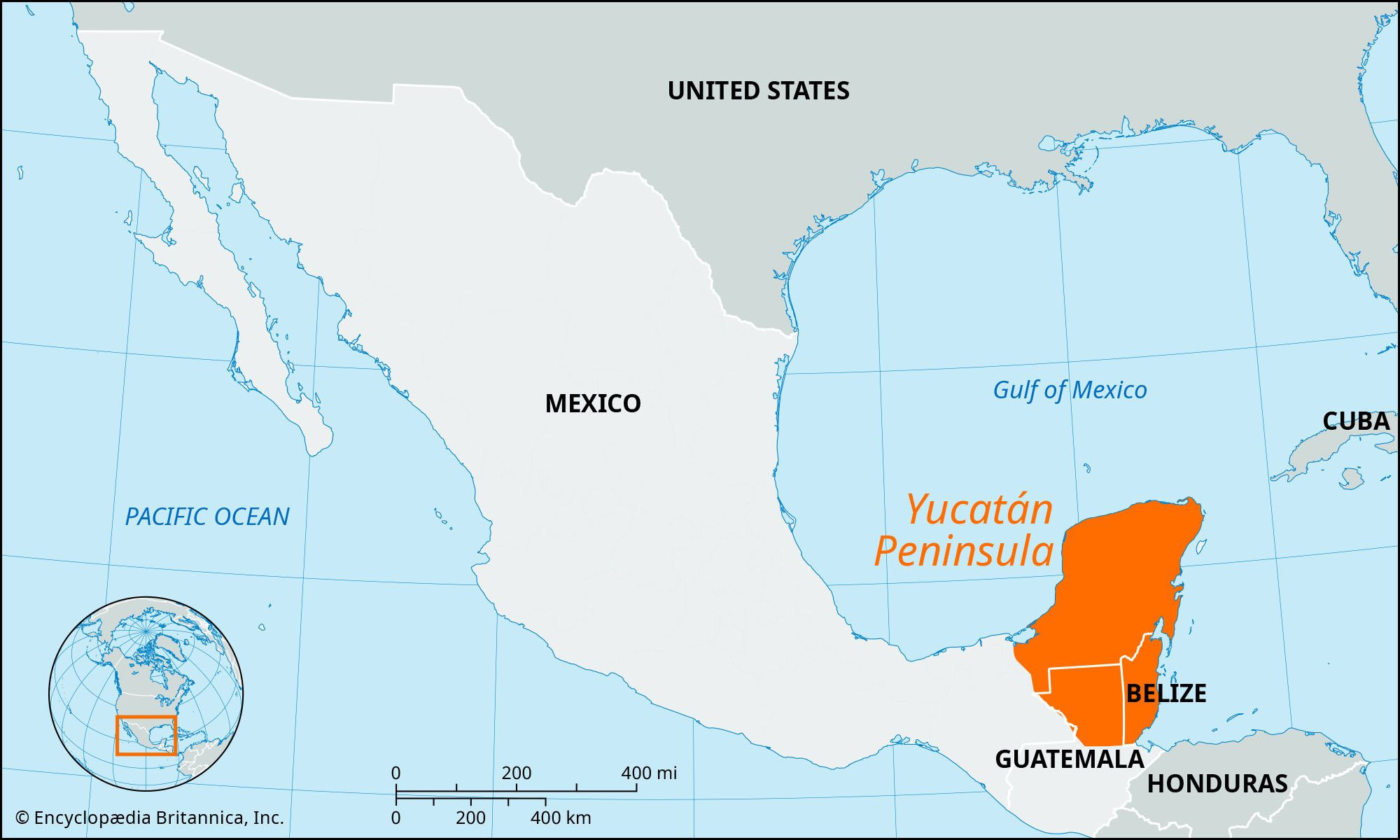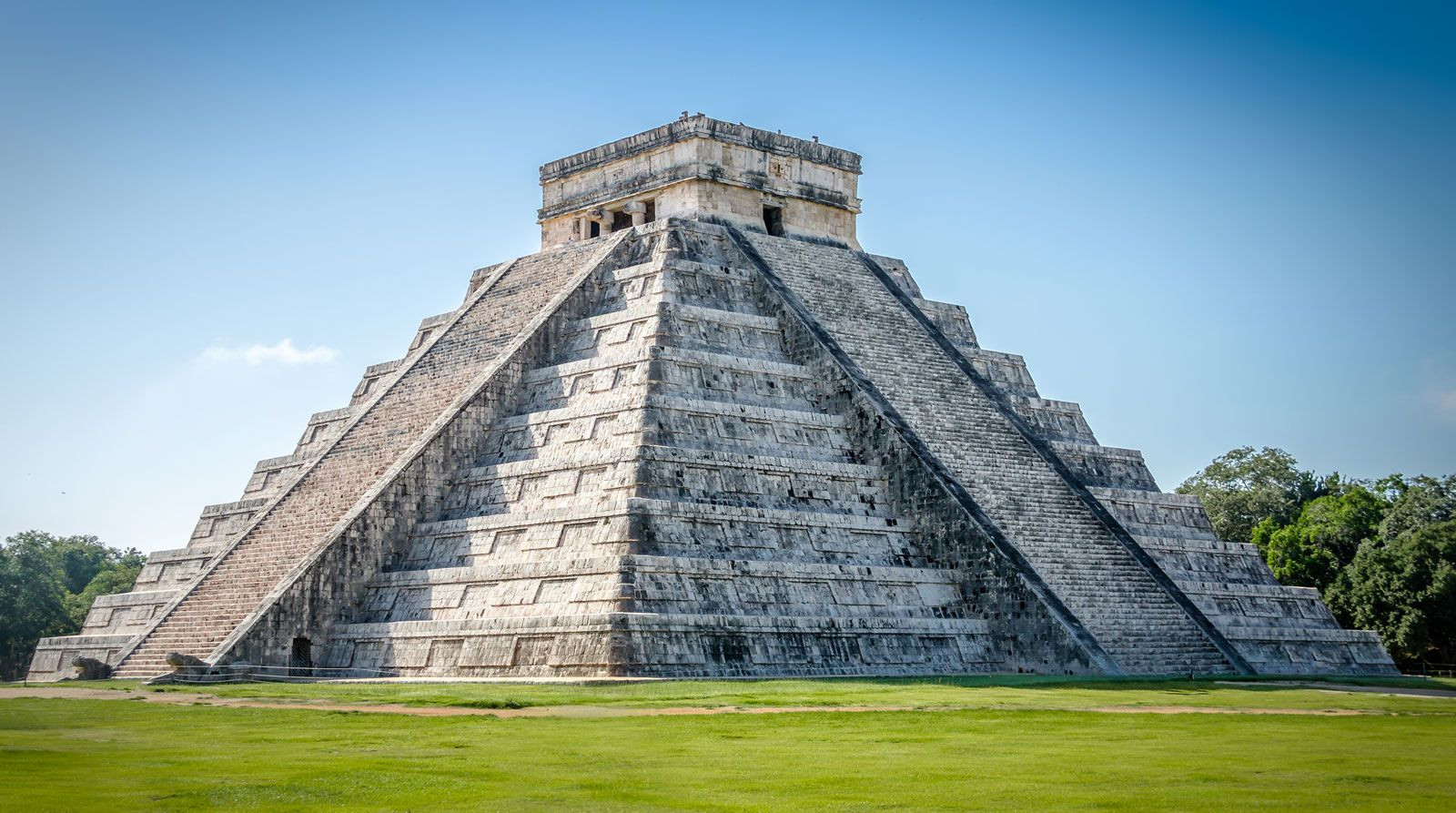The Yucatán Peninsula, a captivating northeastern projection of Central America, is nestled between the Gulf of Mexico to its west and north, and the mesmerizing Caribbean Sea to the east. This expansive landmass, covering approximately 76,300 square miles (197,600 square km), encompasses the Mexican states of Campeche, Quintana Roo, and Yucatán, along with significant portions of Belize and Guatemala to the south. With an average breadth of about 200 miles (320 km) and a coastline stretching around 700 miles (1,100 km), Mexico’s Yucatan Peninsula is a region of diverse landscapes, rich history, and vibrant culture, beckoning travelers and explorers alike.
The Diverse Geography of the Yucatan Peninsula
The geography of Mexico’s Yucatan Peninsula is strikingly varied, contributing to its unique appeal. The northern and western coasts are characterized by their low-lying, sandy, and somewhat barren nature. Despite their semibarren appearance, these coastlines are punctuated by openings that have fostered the development of small towns and ports, serving as gateways to the peninsula. In contrast, the eastern coast presents a dramatic landscape of bluffs, intricately carved with bays and fringed by a chain of islands. Among these, Cozumel and Isla Mujeres stand out as the largest and most developed, offering distinct island experiences within the Yucatan. The entire coastline of the Yucatan Peninsula is renowned for excellent fishing opportunities and boasts numerous stunning beaches, with those in Cancún achieving international acclaim as a premier tourist destination and resort area.
The peninsula’s interior is predominantly formed from beds of coralline and porous limestone rocks, creating a low tableland that gently ascends towards the south. This geological composition results in a thin, dry soil layer, a product of the slow weathering of the underlying coral rocks. A fascinating feature of the Yucatan’s landscape is the prevalence of natural sinkholes and caverns, formed where the rocky surface is perforated. These cenotes, as they are known locally, were not only vital sources of freshwater but also held significant cultural and religious importance for the Maya civilization, who strategically built their cities and ceremonial centers around them.
The climate across Mexico’s Yucatan Peninsula varies significantly. The northern Yucatan experiences a hot and dry climate, characterized by limited rainfall due to the absence of high mountain ranges that could intercept moisture-laden clouds from the Atlantic. As one moves southward, rainfall gradually increases, ranging from approximately 18 inches (460 mm) to as much as 80 inches (2,000 mm) annually. This increase in moisture leads to a transformation in vegetation, with scrub forests giving way to taller, more lush tree cover in the southern regions. Daily high temperatures across the peninsula typically range from the mid-70s to 100 °F (about 24 to 38 °C). However, the heat is often tempered by refreshing ocean breezes for much of the year. The peninsula experiences a distinct dry season from December to May, with May and June being the hottest months. Despite the dry season, most of the Yucatan Peninsula receives adequate rainfall throughout the year, sustaining its diverse ecosystems and agricultural activities.
 Yucatan Peninsula Locator Map
Yucatan Peninsula Locator Map
The western regions of Campeche and areas within Belize benefit from sufficient rainfall to support rich forests. These forests are a treasure trove of valuable tree species, including mahogany, sapodilla, vanilla-producing orchids, and logwood, along with other dyewoods historically prized for their vibrant colors. Logwood forests are particularly prevalent along the lagoons and many sections of the coastline. The Yucatan Peninsula is also teeming with diverse animal life, including deer, jaguar, wild boar, monkeys, snakes, and iguanas. Bird enthusiasts will be delighted by the abundant birdlife, especially turkeys, quails, and parrots, adding to the peninsula’s natural charm.
People and Culture: The Heart of the Yucatan
The population distribution across Mexico’s Yucatan Peninsula is uneven, with varying densities and ethnic compositions. Mérida, the capital of Yucatán state, and its surrounding region are densely populated, serving as a cultural and economic hub. In contrast, the southeastern Mexican state of Quintana Roo is the most sparsely populated part of the peninsula, retaining a sense of remoteness and untouched natural beauty in many areas. The majority of the population in the Yucatan consists of Maya people and mestizos, individuals of mixed Indigenous Maya and European ancestry. The three Mexican states within the Yucatan region are particularly characterized by their predominantly Maya population, reflecting the enduring legacy of this ancient civilization. In Belize, approximately half of the population is mestizo, defined locally as having mixed Mayan and Spanish ancestry, while the remainder includes Maya, Creole (English-speaking people of largely African and British descent), and other diverse groups. Guatemala’s population is also predominantly mestizo, with a significant Maya population constituting the majority of the remainder. This rich tapestry of cultures contributes to the unique identity of Mexico’s Yucatan Peninsula.
Economy and Tourism: Modern Yucatan
 Mayan Pyramid at Chichen Itza, Yucatan Peninsula
Mayan Pyramid at Chichen Itza, Yucatan Peninsula
Agriculture remains a vital part of the economy of Mexico’s Yucatan Peninsula. Corn (maize), sugarcane, tobacco, cotton, coffee, and henequen, a type of agave cultivated for sisal hemp production, are important crops grown throughout the peninsula. In addition to agriculture, the Yucatan Peninsula has seen the discovery of oil in several areas, with a gas field at Xicalango and offshore oil fields near the Bay of Campeche contributing to the region’s energy resources. Logging and chicle industries also play a significant economic role, particularly in Belize. However, in recent decades, tourism has emerged as a dominant economic force in Mexico’s Yucatan Peninsula. The region’s wealth of archaeological sites, including the world-renowned Chichén Itzá and Uxmal (both designated UNESCO World Heritage sites in 1988 and 1996 respectively), as well as Tulum, has made it a magnet for cultural tourism. Coupled with the development of a robust transportation network, including highways and air links connecting Cancún and other major tourist centers to Mexico City and international destinations, tourism has become a cornerstone of the peninsula’s economy.
A Glimpse into Yucatan’s History
The modern history of Mexico’s Yucatan Peninsula, historically referred to as Mayapán by Mexicans, began with the arrival of Francisco Hernández de Córdoba, a Spanish adventurer from Cuba. In February 1517, while on a slave-hunting expedition, Córdoba discovered the east coast of the Yucatan, marking the first European contact with the region. Juan de Grijalva followed Córdoba’s route in 1518, further exploring the coastline. In 1519, Hernán Cortés, the famous conquistador, led a third expedition, encountering resistance from the inhabitants of Cozumel Island. Cortés himself traversed the inland part of the peninsula in 1525 during an expedition to Honduras, expanding Spanish knowledge of the territory.
The conquest of the Yucatan Peninsula was initiated in 1527 by Francisco de Montejo. Unlike Cortés’s relatively swift conquest of other parts of Mexico, Montejo faced fierce and prolonged opposition from the Maya. By 1549, after decades of struggle, Montejo had only managed to establish Spanish rule over approximately half of the peninsula, and Spanish control never extended further into the Maya territories. During this period of conflict, many Maya people abandoned their cities and retreated into the rural inland areas of the peninsula, seeking to preserve their way of life.
Throughout the colonial period, the Yucatan remained a remote and less significant part of the Viceroyalty of New Spain, which was centered in Mexico City. Following Mexican independence, the Yucatan declared its secession from Mexico in 1839 and maintained its independence until 1843 before rejoining. However, in 1847, another major revolt erupted, known as the Caste War of Yucatán. This rebellion resulted in the Maya achieving virtual independence across much of the peninsula for a significant period, lasting until the administration of Porfirio Díaz began in 1877. Even in 1910, another revolt occurred with initial successes, leading many Maya to withdraw further into the sparsely populated state of Quintana Roo, seeking autonomy and isolation.
Historically, until the 20th century, Mexico’s Yucatan Peninsula maintained stronger connections with Europe and the United States than with the rest of Mexico. The people of the Yucatan, predominantly Maya, have often distinguished themselves from broader Mexican identity, sometimes eschewing being called “Mexicans,” reflecting their unique cultural heritage and historical experiences. It wasn’t until 1957 that a significant infrastructural change occurred, with the widening of a narrow-gauge railway line to mainland Mexico. This development facilitated the movement of heavy freight and strengthened the peninsula’s integration with the rest of the country. Despite increasing integration, Mayan culture and traditions have remarkably persisted and continue to thrive in the Yucatan Peninsula into the 21st century, making it a living testament to a rich and resilient heritage.
In conclusion, Mexico’s Yucatan Peninsula is a region of unparalleled beauty and historical significance. From its stunning coastlines and mysterious cenotes to its ancient Mayan ruins and vibrant culture, the Yucatan Peninsula offers a captivating blend of experiences for every traveler. Exploring this unique corner of Mexico is a journey through time, nature, and culture, leaving a lasting impression on all who visit.